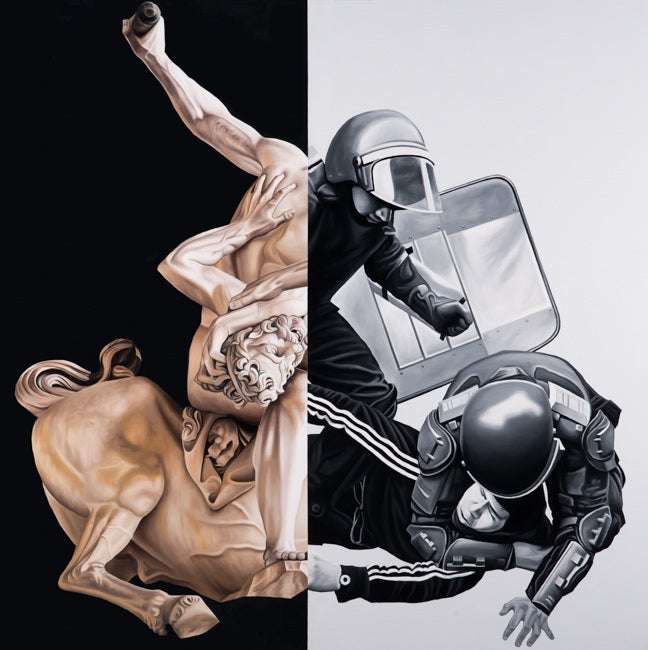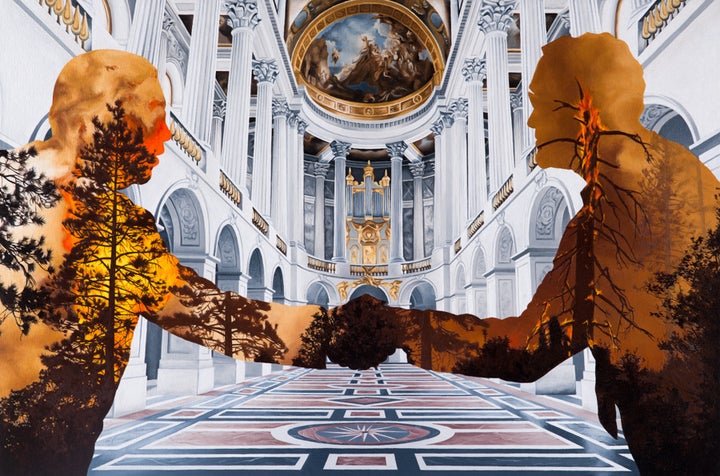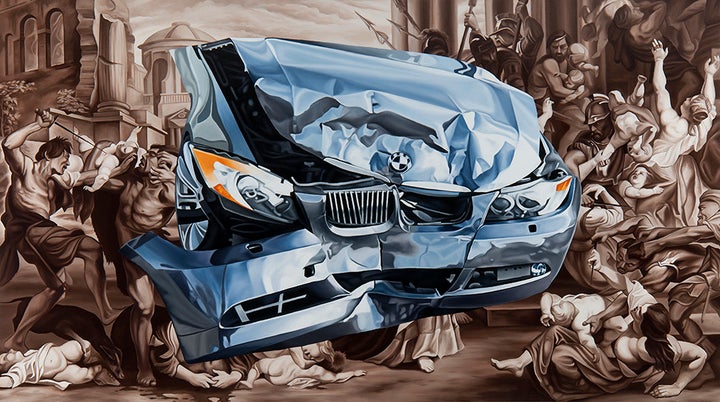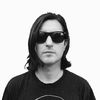
On the occasion of painter Jake Scharbach’s solo show opening this Friday at Brilliant Champions in Brooklyn, I caught up with him via email to discuss the exhibit, his background and ideas about life. The results are classic Scharbach: dark and hilarious. Over the last twenty years I've known Mr. Scharbach I've watched him become one of the best painters of his generation. He would be the last to agree with that statement. Below is an excerpt.
MN: Let’s begin by a telling me a bit about this series of new paintings you are exhibiting.
JS: I always thought they would look nice as billboards along the freeway. That you would see them while stuck in traffic, through the glass of a windshield. I wanted to start a revolution.
MN: A revolution? Is that even possible via painting?
JS: It's totally futile. But I love the idea. Art does have the capacity to be dangerous. I'm attracted to that. Even if I fail at it. I want to keep trying.
MN: Where is the imagery coming from? I know that you travel a lot.
JS: I'm using images from my bike trips to Europe as well as pictures from google image searches.
MN: Can you expand on this a little bit more? What is compelling to you about these bike trips that turns into source material? Is it the sense of liberation?
JS: It is just a way of life that led me to thinking about history. Traveling brings you to a vulnerable state. You know when you see something that cuts through your whole being. You question everything after that. Your perspective zooms out into the universe. That's how riding my bike into those little towns all over Europe felt to me. It seemed natural and obvious to use that historical imagery as a place to begin to try and make a visual comparison.
MN: Let’s talk about the exhibitions you did recently in Chile. The quality of the painting is excellent. How did audiences react in Chile recently when you had that museum show?

JS: I think of myself as a very utilitarian painter, not very imaginative or adventurous. I'm basically a sign painter, like Rosenquist but not as skilled. I like direct imagery. It's a meditation to simplify things into a central focus without distraction. I guess the directness of advertising got its claws into me. I want to use that visual language to question our cultural programming.
I had a show at the Museo de Arte Contemporaneo with some of these paintings in Santiago Chile. I'm not sure how it went. There weren't riots in the street that day. But I guess people responded. How would I know? I mostly stayed outside and smoked cigarettes the whole time. Being the center of attention is just awful.
MN: I agree. Every time I’ve had a film screening or an exhibition it makes me feel too weird and nervous. It’s not like I care what people think, but it’s like a high concentrated dose of public opinion in your face.
I do see those sign painter qualities. I also see your point about being a “utilitarian painter” which is a perfect vehicle for your ideas. In your paintings the imagery is the most important thing. It’s not painting about painting which is a tired ass idea. I’m imagining it takes weeks to months to do these pictures. Do you work on several at once?
JS: There is something perverse in asking an artist to be present at the event. It's pointless torture. How can the work possibly be enhanced by its creator standing stupidly in the corner with flies circling his head?
I want the way I paint to be invisible. It's a problem with painting, technique is a distraction, especially if you paint realistically. I haven't found a solution. I paint just good enough to make a clear picture, but bad enough that no one will swoon over the mastery of the brushwork. I like when Warhol said if you want to understand his paintings, just look at the surface.
It takes a long time. I don't keep track. I can only paint about once a year and I will work day and night for a few months. It's totally unhealthy. I don't recommend it. I run myself into the ground. I will usually do between 5 and 10 paintings during that time. I'm mostly motivated by desperation and addiction.
MN: Bendito. I've seen you in these periods. You're like a caveman. I literally laughed out loud about your quip about the perverse torture of having to stand there in front of the unsympathetic public and take the stones of persecution.
JS: I don't feel persecuted or defensive so much as just a useless appendage. I'm like an extra sleeve sewn on to a perfectly good shirt, just dangling there ridiculously. I don't know what to do with myself. What to say. I spend most of my time trying to avoid people.
MN: I’ve noticed that the images that you pull off of Google image search have a political feel. Are they statement paintings at all?
JS: No, I don't have anything to say in any kind of political way. The images I choose are the ones that I respond to internally, maybe even subconsciously. They resonate with my own aesthetics.
MN: I think you are unaware of it, but a political point of view has emerged.
JS: Maybe, but I hope it's not a critique of politics in terms of liberal vs conservative. That analysis bores me to death. It's irrelevant. If there is a critique, it is of civilization as a whole, the scope of human proclivities. Those are the bigger and more fascinating questions.

MN: Tell me a bit about your background. Where did you come from?
JS: Naselle Washington, land of logging trucks and fishing boats.
MN: You’ve told me about Naselle. Small population, your dad built your house which i believe was a mud hut, correct? Weren’t there like 4 kids in your graduating class?
JS: Naselle is a small rain soaked town on the Columbia river, near the coast. The major industry is logging, and….maybe drinking. It's basically a grocery store and a couple taverns and churches. We had 30 or so kids in my graduating class and it was the largest one on record. Kids drove big trucks to school with gun racks in the rear window stacked with rifles equipped with high powered scopes and no one thought twice about it.
My dad built our house with a handsaw and a hammer because there was no electricity out there. We grew up eating deer and elk. My mom cooked on a wood stove. It was a great life for a kid. It was pretty lawless and there was plenty of fun things to do: build forts, go fishing, collect bugs, shoot guns, explore the woods. Since we didn't have tv my sister and I drew our own magazines and read a lot. It forced us to be creative. It wasn't as cool as living in a mud hut but then again, what is?
MN: My hyperbole above sounds cunty. I didn’t mean that to sound that way.
JS: It made me laugh! And we did grow up in the mud! Mud is the defining characteristic of the Pacific Northwest. We were the dirty kids at the end of a muddy road wearing boots covered in mud playing out in the muddy banks of creeks. We were filthy critters.
MN: Where is this exhibit you’ve got coming up here in Brooklyn?
JS: The Echo’s Decay opens at Brilliant Champions Gallery in Bushwick, Oct. 14th, 6-9 pm.
Brilliant Champions 5 Central AveBrooklyn, NY 11206www.brilliant.gallery(646) 543-9591
